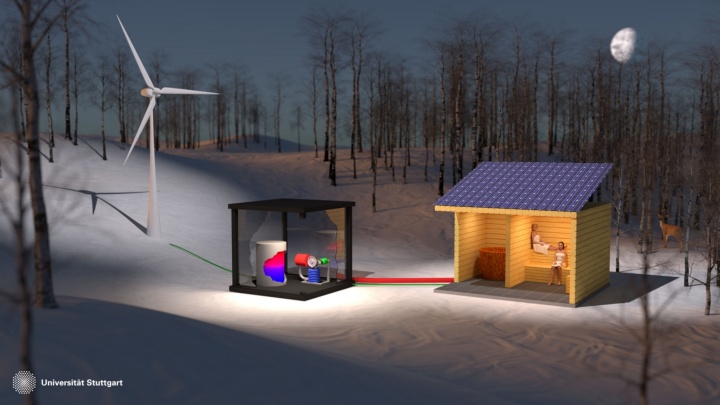A sauna that generates and stores its heat from renewable energies – this unique concept has been developed by a young research team under Professor André Thess from the University of Stuttgart and the German Aerospace Centre (DLR). On Tuesday, 17th April 2018 the young researchers and graduates, Julian Vogel and Daniel Pfeiler for the first time presented three variations of its “zero-energy sauna” in the framework of a colloquium.
Relaxing in the sauna and strengthening the immune system – for many people a particularly tempting wellness offer. Yet comfort has its price because saunas have a high-energy requirement. Just a normal visit to the sauna in a home sauna requires around 15 kWh.
Initially the “zero-energy sauna” also has a high-energy requirement – however, with one decisive difference: whilst heat in a conventional sauna is generated with power from the network, the “zero-energy sauna” generates and stores its entire heat locally and CO2 neutral from renewable energies. Similar to the “zero-energy house” it therefore constitutes an self-sufficient energy system. However, in order for the “zero-energy sauna” to really be environmentally friendly it should be particularly long-lasting. Since electrical energy storage devices such as batteries do not meet this requirement with their current technological status, a sophisticated energy storage and converting system is at the centre of the concept.
Yet there are a variety of saunas: whilst Europeans mainly like it hot and dry (Finnish saunas), in the Orient they prefer warm and humid (Hamam). At the same time there is a high availability of wind power in Europe, whilst in the Orient there is an almost unlimited availability of solar energy.
The Institute of Energy Storage from the University of Stuttgart in cooperation with the Institute of Technical Thermodynamics from DLR have developed possible concepts for both sauna variations and locations. The concept for the Finnish sauna comprises the coupling to a small wind power plant and integration of an innovative energy storage and converting system. The concept for the Hamam correspondingly provides for supply through solar energy. Its innovation comprises the direct generation of steam. Both models are rounded off by a third concept, the affordable “Schwaben” model for the state. This model captivates with its simplicity and efficiency. Thanks to a hybrid heat and steam storage system, it enables a flexible sauna operation.
The researchers have already registered their invention for patent approval. The Institute of Energy Storage would like to initiate a workgroup in perspective that contributes towards the demonstration and commercialisation of the “zero-energy sauna”.
Expert Contact:
Micha Schäfer, Universität Stuttgart, Institut für Energiespeicherung,
Tel.: 0711 685-62662, E-Mail


